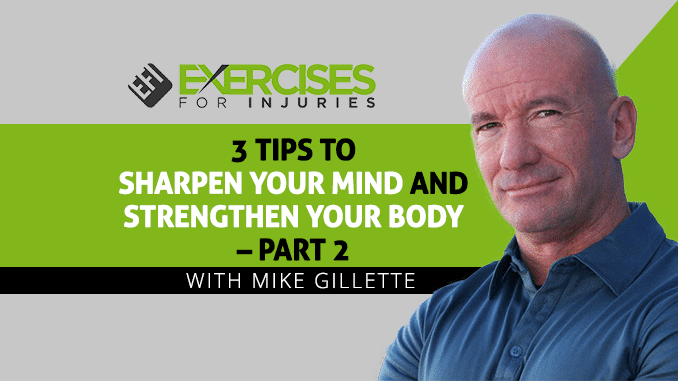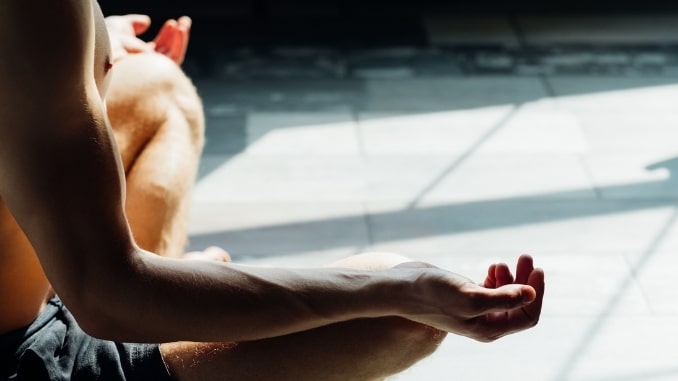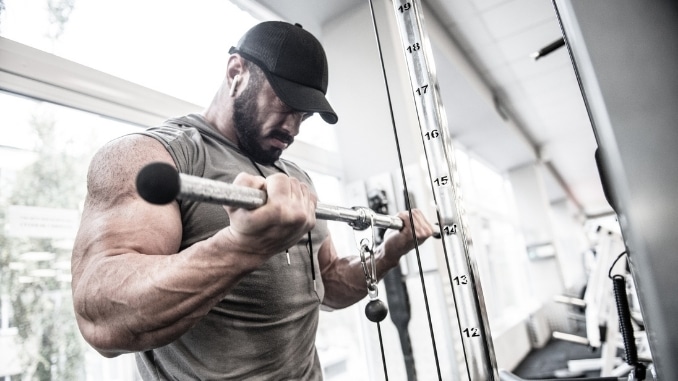
Here’s the second part of the interview I had with Mike Gillette on 3 Tips to Sharpen Your Mind and Strengthen Your Body. Learn more about his mental strength techniques through this interview below.
Enjoy!
Rick Kaselj, MS
P.S. – Before you listen to the interview below, make sure to check out part 1 over here.
CLICK HERE to watch the YouTube video interview.
In the interview above, you will discover:
- Three tips to sharpen and strengthen your mind
- How to effectively set up your goals when it comes to strength training?
- Time investment when it comes to mind and body strength training
- Understanding the risk of injury when doing strength training
- How to avoid injury when doing strength training
- Mike Gillette shares his own injury experience and what he did to overcome it.
I hope you enjoyed the interview.
If you want more information on Mike Gillette, you can visit him at MikeGillette.com.
Take care, and have a great day.
Rick Kaselj, MS
If you cannot watch or listen to the interview, check out the transcript below.
3 Tips to Sharpen Your Mind and Strengthen Your Body
Rick: Now, if we looked at and left people with three tips they can do to sharpen the mind and strengthen the body? And looking at sharpening the mind, we’re talking about sharpening the saw and overcoming physical obstacles.
Mike: Okay. If I put it into a three-tip format, I would make it very, very simple. And I would say your three tips are three steps, the first of which is a goal.
1. Goal
Decide upon a goal that could be a brand new goal or something that you’ve been kind of banging your head against for a while but will use because most people struggle with this. Exercise or getting the food intake under control or managed or deliberate. And so many people just kind of half-ass that. They don’t get specific; they don’t have an actual plan other than “I need to get back in shape.” What does that mean? That is vague to the point of absurdity. Give that some shape; give it some specificity.
So, turn it into an actual goal. I want to lose X pounds, I want to gain X pounds, I want to hit this poundage on a particular exercise. I want to: something specific and measurable. Create a goal that would be tip one.
2. Plan
Now we have a goal in mind; we need a plan. How are you going to do this thing? Figure out a plan, a roadmap towards accomplishing it.
3. Execution
And then, tip three is executed. Execute, execute. Actually, do the thing. I got a great goal, sounds awesome; look at this plan; I got like Excel spreadsheet graphs, it’s awesome, and it’s on my desk.
Once upon a time, I was working for a gentleman whose previous job was as a squadron commander of Delta Force, sometimes called “The Unit”, that’s what the name of the TV show was. He used to supervise the most accomplished, smartest, fastest, scariest warriors on the planet. And one day, we were having a meeting on a very large training project, and he walked in, he just kind of stood there.
Because he’s good at this, he listens. He doesn’t just jump in and start yelling and doing that. He listens, takes a pulse of the room, and then says, “You know what? I think we have had just about enough great ideas. What we need now is some violent and then some colorful f-bombs execution”. There comes a time. Planning is great, but then you’ve got to go. You got to do the work.
And so my three tips are goal, plan, and execution, and all three of them are equivalently important. You see, guys execute all over the place, but they don’t have a plan. “What are you trying to do?”

“I’m just at the gym, bro. I’m just getting it.”
Well, getting what? Besides tired, sweaty, and loud? You need to be specific, have a way to get from point A to point B, and then you have to violent execution. It doesn’t have to be violent, but I like it that way. (laughing) Enthusiastic, without restraint, go, go, go, hard stuff.
Overcoming Pain and Injuries
Rick: And that applies to strength and fitness goals, but in many ways it applies to overcoming pain and injury. I mean, you need to have a goal, you need to have a plan, and probably the most important thing is the execution of the plan back towards the goal. So it’s almost like a big circle.
Mike: Absolutely. Absolutely. Because the thing is, if we have the goal and we have execution but we don’t have a plan, we don’t know if all of our efforts are kind of meaningfully or functionally leading towards that goal. We can find ourselves over here and feel like we’re doing stuff because oh man, we’re executing up a storm, but without a good plan, it’s not the most efficient use of our time and energy.
Rick: I meant to say earlier in the interview, you’re talking about the time investment when it comes to mental training or sharpening the saw of the mind.
Mike: I call it the sword. I mean, saws are cool, but the sword is, don’t cut the sword. (laughing)
Phases to Face
Rick: You end up going through phases. If you look at your career, you went through a phase where you’re in the army, and you’re focusing on different skills related to the army. And then you moved into law enforcement, and focused on different skills there and went into bodyguard work. So even when it comes to mind training, you could take a period. Like the program you were talking about, you can dedicate a month to learning the skills, refining the skills, and improving to get the benefit that will result from that one-month investment.

Mike: Absolutely. I keep seeing this on social media saying, “You need to start your day by making your bed.” And the idea is that the first thing you do is something productive, and it’s something routine and productive that you build into your day that there’s a carryover.
So when we’re talking about mental strengthening exercises or physical strengthening or hopefully harnessing the two of those, what we’re doing is we’re building in habits, we’re building in a productive routine and that ideally there’s a carryover.
I think a stronger person is a smarter person. In my worldview, a strong person makes the world a better place. The strong person feels better about themselves and will radiate confidence, reliability, and stability. They bring that to their relationships, their family relationships. They’ll be a better neighbor, a better friend, a better community member. So carryover ultimately is everything.
And I think a stronger person makes better decisions or is equipped to. I mean, you know it can run amuck. You’re only as good as you decide to be. You can be a strong jerk if you want to be, but why would you want to be? Because I think at the end of the day, everyone, male/female, aspires to be the strong heroic type. We all need to connect with that heroic element of our character, our better nature. And being strong, making good decisions, doing the right thing when it’s difficult to do the right thing, and developing self-discipline, radiates out into the world.
Last Minute Points
Rick: Awesome. So we’re at the end of our interview. Is there any last-minute points that you want to leave people with, or was there a question that I didn’t ask you that you wanted to share with people?
Mike: Well, because you have so many people I think that tune in to you or they’re dealing with or want to prepare themselves for how to cope with injury and so forth, if we can touch on that just a second before we finish up.
Because I’ve dealt with injuries myself, and I’ve worked with a lot of people dealing with various types of injuries, sometimes very significant. The kind of work I’ve been involved with over the years, you can get hurt doing this kind of stuff, you know?
Rick: You can die! (laughing)
Mike: And a lot of guys do. So one of the things that I’d like to share is a couple of years ago, in 2011, I injured myself. I tore my right bicep right off the bone. Training accident, not doing anything crazy that people might think, but we’re doing some combative training, and I was coaching a guy through an arm bar control hold.
He had two arms on my one, and I was encouraging him to put some pressure on me. Which he was doing, but he’s being cautious and professional about it, and what I didn’t realize at the time is after only having done feats of strength for a couple of years, my pain threshold is completely miswired now.
I have no normal sense of pain, and, you know, the protective mechanisms of the body don’t kick in when they should. And this may be some of your listeners, so just because something doesn’t hurt yet, even though it looks like it should, things might be happening that you’re unaware of. Especially when you’re my age, be cautious.
I was 49 at the time, and people get lots of “advice” from people when they’re injured. From well-meaning people who may be close to you, from people who maybe never really understood what that guy’s deal or girl’s deal anyway. So they’re saying things like, “You know Mike, you’re not getting any younger. Maybe this is a sign that maybe you should stop,” and you get all that sort of thing.
This is unnecessary because we’re always asking ourselves, particularly when injured, those very same questions. Have I been pushing it too hard, can I come back? How do I sort of rediscovering who I am physical? Where do I go from here? All of those things are always rolling around your head.
There is so much discouragement that which I think is normal, that may even be part of the body’s protective system which is okay. Engage the brain, and start asking some really deep soul-searching questions right now, but not to get consumed by that. That was one of the things I dealt with way back in ’85, ’86, ’87, and ’88 when I was trying to physically rehab myself.
I had gone from being the guy who got perfect scores in every one of his army PT tests to a guy who was lurching around the University of Arizona in this steel back brace with those wrap-around gimpy crutches. And at the time, you will never run again, you’ll never jump out of any airplanes, I had a laundry list of things I would never do again.
I was 22 years old and physically I was being told I was done. So there’s always a considerable amount of discouragement. And we have to, when we’re injured, recognize that for what it is and not to get just absolutely consumed by that. And I think the best way out of that pit is to always do something. I mean scale it on back, ratchet back the intensity, but find something to do.
If your legs are biffed up, then do something that doesn’t involve them. If it’s this arm, do something with this arm, work a lot of squats, but find a workaround so that you can stay proactive, so you can continue to move, so you can continue to make progress on some level. It will be tremendously therapeutic for you to not stop.
Going cold turkey for somebody who wants to push their own personal physical envelope is I don’t think a recipe for success. So that’s my advice for anyone who’s dealing with an injury whether serious or not so serious. Do something. Keep the head right, keep engaged, forward movement always. Whatever you can do, make it as excellent as possible.

More about Mike
Rick: Awesome. I don’t really have much more to add to that. Great advice, and then where can people get more information about you, Mike?
Mike: The easiest place to get more information on me is to go to mikegillette.com. This is where they can learn more about what I do as a coach and I’ve just got a lot of free content on that site. A lot of blogs are all relentlessly positive in nature and potentially extreme because that’s who I am. And that’s where they’ll find things like social media, Instagram, YouTube channel, Facebook, all that kind of stuff, too. I love to have people find me there, hang out, and share some love, share stories of accomplishment, that kind of thing. That’ll be great.
Rick: Awesome. So thank you very much, Mike.
Mike: Loved it. Great talking to you, Rick.
For your equipment-free workout to lose weight and tone your body, check out the Bodyweight Blender program, here!

